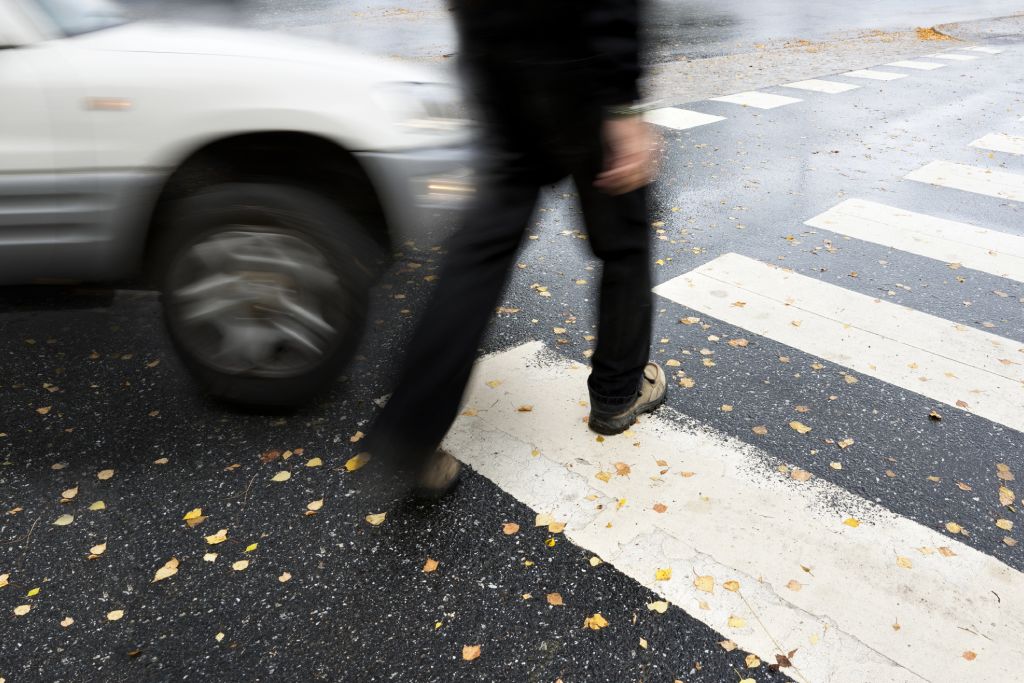Arizona is known for its sprawling streets, fast-moving traffic, and sunny weather that encourages walking year-round. But with that pedestrian activity comes a crucial question: Is jaywalking illegal in Arizona? Understanding this answer isn’t just important for staying safe; it can also play a major role in personal injury claims if a pedestrian accident occurs.
At Wyatt Injury Law Personal Injury Lawyers, we help injured pedestrians protect their rights, seek compensation, and navigate Arizona’s traffic and personal injury laws. Whether you're unsure about traffic control signals, crosswalks, or how jaywalking could impact your legal claim, we’re here to provide clarity and fight for those harmed by negligent actions on the road. Contact Wyatt Injury Law Personal Injury Lawyers today to learn how we can help.
What Is Jaywalking?
Jaywalking generally refers to crossing a street outside of a marked crosswalk or ignoring traffic control signals, especially when doing so puts the pedestrian at risk of a collision with a vehicle. In legal terms, jaywalking occurs when someone crosses the road unlawfully, typically:
- Between two adjacent intersections with working signals, outside of a marked crosswalk
- Against pedestrian signals or traffic lights
- Diagonally across an intersection without permission
- Emerging from between parked cars or crossing mid-block in high-traffic areas
In Arizona, jaywalking is not a criminal offense, but it is illegal under certain conditions and can result in fines or citations under local municipal codes and state law. While the penalties are typically minor, being cited for jaywalking can complicate matters if you're later involved in a pedestrian accident. Understanding when and where it’s legal to cross the street is essential; not just for your safety, but also for protecting your rights in a potential personal injury case.
Jaywalking Laws in Arizona: What You Need to Know
Under Arizona law, pedestrians are required to follow specific rules when crossing roadways. According to Arizona Revised Statutes § 28-793, the following rules apply:
- Pedestrians must yield the right-of-way to vehicles when crossing outside of a marked crosswalk or an unmarked crosswalk at an intersection.
- If traffic control signals are present, pedestrians must obey the pedestrian signals and only cross when the signal indicates it is safe to do so.
- Crossing between two adjacent intersections with working signals (also known as a functional intersection) outside of a crosswalk is prohibited—this is a typical scenario of jaywalking.
Is Jaywalking Illegal in Arizona?
In many situations, jaywalking is illegal in Arizona. While it's often treated as a civil infraction rather than a criminal offense, it can still lead to:
- Fines or warnings issued by law enforcement
- Legal complications in the event of a pedestrian accident
- A possible finding of comparative negligence in a personal injury case
Some cities, such as Phoenix, Tempe, and Scottsdale, may have stricter or more detailed ordinances that supplement the state law.
Legal Implications of Jaywalking in a Pedestrian Accident
If you're injured in a pedestrian accident while jaywalking, that doesn't automatically mean you’re at fault, but it can affect your ability to recover damages.
Comparative Negligence in Arizona
Arizona follows the pure comparative negligence rule. This means that even if a pedestrian is partially at fault, such as crossing illegally, they can still seek compensation in a personal injury claim. However, their total award may be reduced by the percentage of fault attributed to them.
For example:
- If a jury finds you 30% at fault for crossing against a light, but the driver was distracted or speeding and 70% at fault, your damages would be reduced by 30%.
This makes it critical to work with a skilled legal team that understands jaywalking laws and how to argue for your rights, even when liability is shared.
Does Jaywalking Mean You Can’t File a Claim?
No. Even intoxicated pedestrians or those crossing improperly may be able to file a pedestrian accident claim if a driver's negligence contributed to the incident. Factors like:
- Excessive speed
- Failure to yield the right of way
- Texting while driving
- Running red lights or stop signs
- Not paying attention to the roadway
Can shift the burden back onto the motorist, even if the pedestrian was not fully compliant with traffic laws.

Common Scenarios Involving Jaywalking and Legal Outcomes
Mid-Block Crossings Near Busy Intersections
A person crosses a street halfway between two intersections, neither of which has a crosswalk. A car hits them while speeding. In this case, both parties may share fault, but the driver’s negligent behavior could outweigh the pedestrian’s decision.
Crossing Against the Signal
A pedestrian enters the roadway despite a red “Don’t Walk” sign. The driver has a green light and is not distracted. The pedestrian may be found mostly or fully at fault, but if the driver was speeding or failed to brake in time, fault may still be shared. Each case depends on the specific facts, and even a seemingly minor driver error can shift liability in a personal injury claim.
Accidents in Unmarked Crosswalks
Even if no lines are painted, intersections typically contain unmarked crosswalks where pedestrians still have the right of way. If a vehicle fails to yield, the driver may be held liable, regardless of whether signs or markings are present. Many drivers are unaware of this rule, which can lead to preventable collisions and disputes over fault in a pedestrian accident claim.
Wyatt Injury Law Personal Injury Lawyers’s Role in Pedestrian Accident Cases
At Wyatt Injury Law Personal Injury Lawyers, we represent injured pedestrians across Arizona, including those involved in jaywalking-related accidents. Our job is to determine the full story, not just what was written in the police report.
What We Do for Injured Pedestrians
- Investigate accident scenes and evaluate crosswalk placement.
- Analyze pedestrian signals, signage, and the behavior of oncoming vehicles.
- Obtain footage from traffic cameras or local businesses.
- Work with accident reconstruction experts.
- Handle all communication with the insurance company.
We understand that pedestrian deaths and injuries often happen in complex traffic environments where the right of way isn’t always obvious. Our legal team works tirelessly to prove negligent actions on the part of drivers, even when jaywalking is alleged.
Case Impact: Jaywalking and Liability
In many cases, drivers attempt to shift blame onto injured parties to avoid paying out a claim. Accusations of jaywalking, sometimes unsupported by evidence, can derail valid personal injury cases.
Our attorneys work to:
- Challenge assumptions about fault.
- Demonstrate visibility issues, speed, or lack of warning.
- Show how comparative negligence still supports a strong claim.
Safety Tips for Pedestrians in Arizona
Whether you’re in downtown Phoenix, suburban Scottsdale, or anywhere in between, pedestrians can protect themselves and others by following these safety tips. Arizona’s wide roads and high-speed traffic can make even routine crossings dangerous, especially in areas without dedicated pedestrian infrastructure. Staying alert and making safe choices while walking can significantly reduce your risk of being involved in a serious accident.
Follow All Traffic Control Signals
Only cross when pedestrian signals allow, and never assume oncoming vehicles will stop, especially if they’re turning.
Use Marked or Legal Unmarked Crosswalks
Whenever possible, cross at marked crosswalks or intersections. Even at unmarked crosswalks, drivers are generally expected to yield the right-of-way.
Avoid Mid-Block Crossings
Unless no intersection is nearby, avoid crossing mid-block. This is one of the most common ways jaywalking leads to severe accidents.
Increase Visibility at Night
Wear reflective clothing and use a flashlight when walking after dark. Poor lighting is a significant contributor to pedestrian collisions.
Don’t Walk While Intoxicated
Alcohol impairs judgment and reaction time, even for pedestrians. Many injured pedestrians were under the influence at the time of the incident, which can reduce their chances of recovery.
Stay Alert
Distracted pedestrians are also at risk. Avoid using phones, headphones, or anything that pulls your attention away from oncoming traffic.

Pedestrian Safety and Legal Rights Matter
Pedestrian accidents are all too common in Arizona, and many of them are preventable. While jaywalking is considered illegal in Arizona under certain conditions, it does not automatically disqualify injured pedestrians from pursuing their claims for justice.
Knowing your rights and having a legal team that will fight to defend them is critical to getting the compensation you deserve. Whether it’s medical bills, lost income, or long-term emotional trauma, Wyatt Injury Law Personal Injury Lawyers is here to support you every step of the way.
Call Wyatt Injury Law Personal Injury Lawyers for a Free Consultation
If you’ve been hurt in a pedestrian accident, don’t let the insurance company blame you for crossing the street. Whether you were in a crosswalk, between two adjacent intersections, or accused of jaywalking, you may still have a strong case for financial recovery.
Call Wyatt Injury Law Personal Injury Lawyers today to learn about our personal injury services and schedule a free consultation. Our experienced legal team will thoroughly evaluate your case, clearly explain your rights, and help you understand how Arizona law applies to your specific situation. We handle all pedestrian cases on a contingency fee basis, so you won’t pay anything unless we secure a favorable outcome for you.
